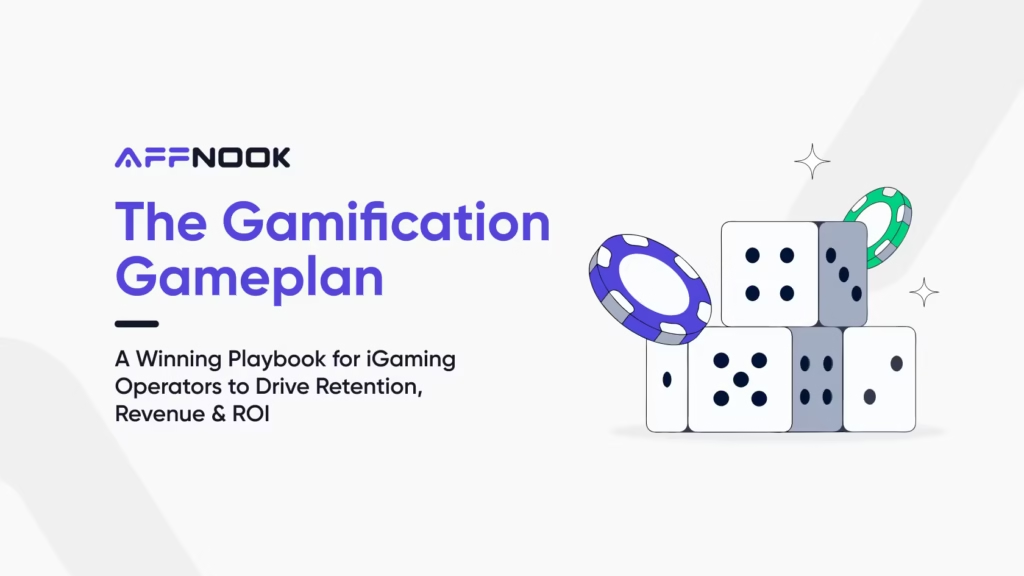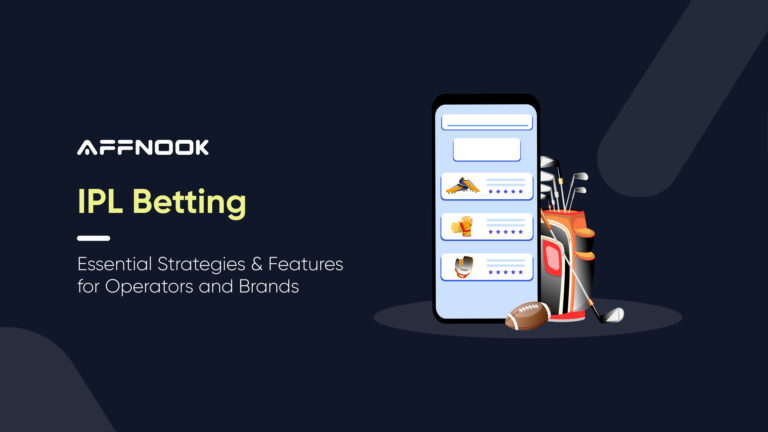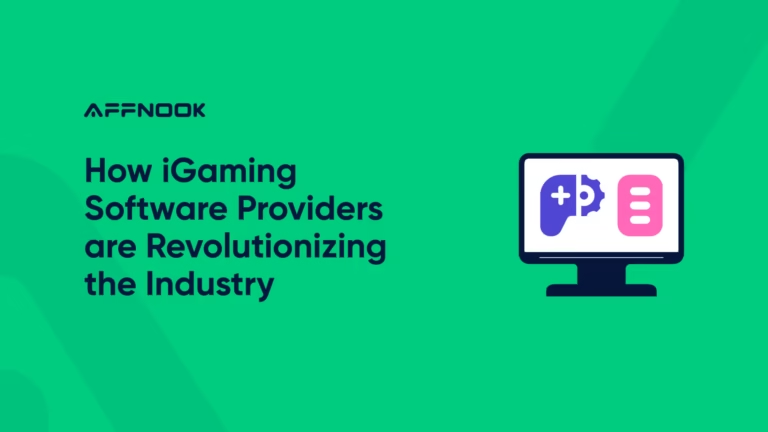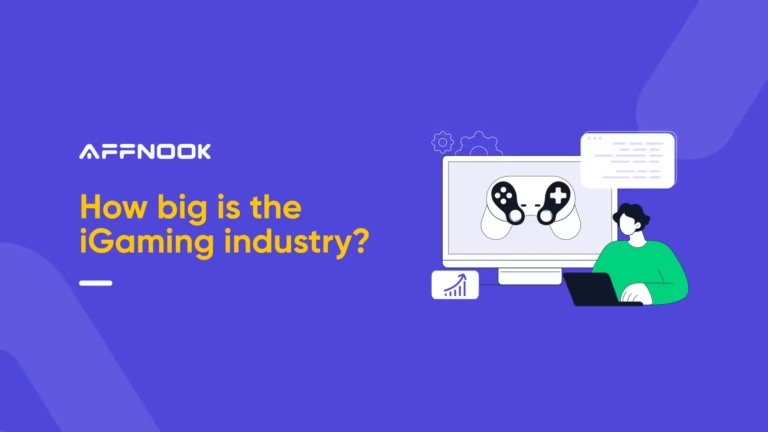In the modern hyper-competitive world, gamification in iGaming industry does not remain a buzzword but becomes a business necessity. Fundamentally, gamification is defined as a process of incorporating game-like features, such as points, challenges, leaderboards, and achievements, into the platform in order to improve user experience and create measurable behavior.
To iGaming operators and brands, this does not only mean fun. It is all about maximizing session length, driving retention, and, most importantly, player lifetime value. It is not merely engaging, it is motivating, personalizing, and it makes users come back.
This blog is your practical guide to successful gamification beyond gimmicks. We will explore some of the most effective tactics, some feature selection guidelines, technology stack decisions, and roadblocks.
Now, how can gamification take your platform beyond transactional and present your brand with a fighting chance in an ever-evolving world of iGaming?
Why Gamification Works in the iGaming Industry
The key to the increased popularity of gamification in iGaming is its psychological roots. Based on behavioral psychology, gamification applies such concepts as operant conditioning, goal-setting theory, and reward prediction error in influencing user behavior. Human beings are inherently driven by performance, development, and reward.
Gamified platforms engage the brain with its dopaminergic reward system by encompassing mechanics such as badges, levels, and leaderboards to stimulate the individual to engage further.
Conventional online gambling sites usually depend on fixed front ends and predictable gameplay. In contrast, gamified platforms are dynamic; they provide quests, streaks, surprise rewards, and competition, all of which are dynamic to the player. This feeling of growth and innovation gives more than a simple boost to engagement but also prompts players to both play and come back more often.
The outcomes are measurable to the benefit of the operators:
- Increased levels of retention due to continuous player drive
- Higher lifetime values (LTV) since players remain invested
- Rich behavioral data to segment and customize offers
- Increased brand loyalty because of a more immersive experience
Gamification serves as a competitive advantage in an oversaturated market where players are free to move platforms and lose. It turns the gaming experience into an adventure with a purpose, rather than a simple bet-giving operators a potent mechanism to become sustainable.
Core Gamification Elements that Drive Results
Effective gamification within the iGaming model requires the implementation of factors that resonate with human psychology, as well as gameplay patterns. The following are the mechanics around which some of the best operators build their strategies to drive engagement, session length, and lifetime value.
Points and Levels
Progression-based gamification is based on points and levels. Users level up as they use points gained in the game or via certain activities, and they unlock new perks, status, or bonuses. This would make the player feel accomplished and stimulate extended gameplay.
Leaderboards
There are leaderboards that create a competitive edge. Operators unlock social motivations by ranking players publicly according to performance, and encouraging them to keep playing, particularly when there are prizes or recognition at stake.
Badges and Achievements
Badges and achievements are rewards received by the user upon achieving a certain task, such as winning three bets in a row or playing a new game. They provide micro-incentives, which promote satisfaction and drive players to high-value behaviors.
Quests/Missions
Guided journeys are presented via quests and missions. Whether they have to complete a series of games within a week or set milestones within a session, it develops a narrative layer that ensures players come back.
Daily/Weekly Challenges
Daily and weekly challenges support the formation of habits. Short-term rewards accompanied by regular challenges assist in platform loyalty and sustaining activity.
Progress Bars
Progress bars provide visual cues and expectation, by making users aware of how near they are to their next payoff—engaging the brain with the drive to do something.
Loot Boxes/Surprise Rewards
Unpredictable answers and fun loot boxes or surprise rewards bring excitement. They are based on variable reinforcement psychology, which keeps the users interested and engaged.
Platforms such as Stake and Duelbits have effectively incorporated these aspects, leading to increased player retention and a more active community. The trick is to implement it critically—gamification must not feel like an afterthought in marketing; it needs to be so native to the game itself that it is hard to distinguish between the two.
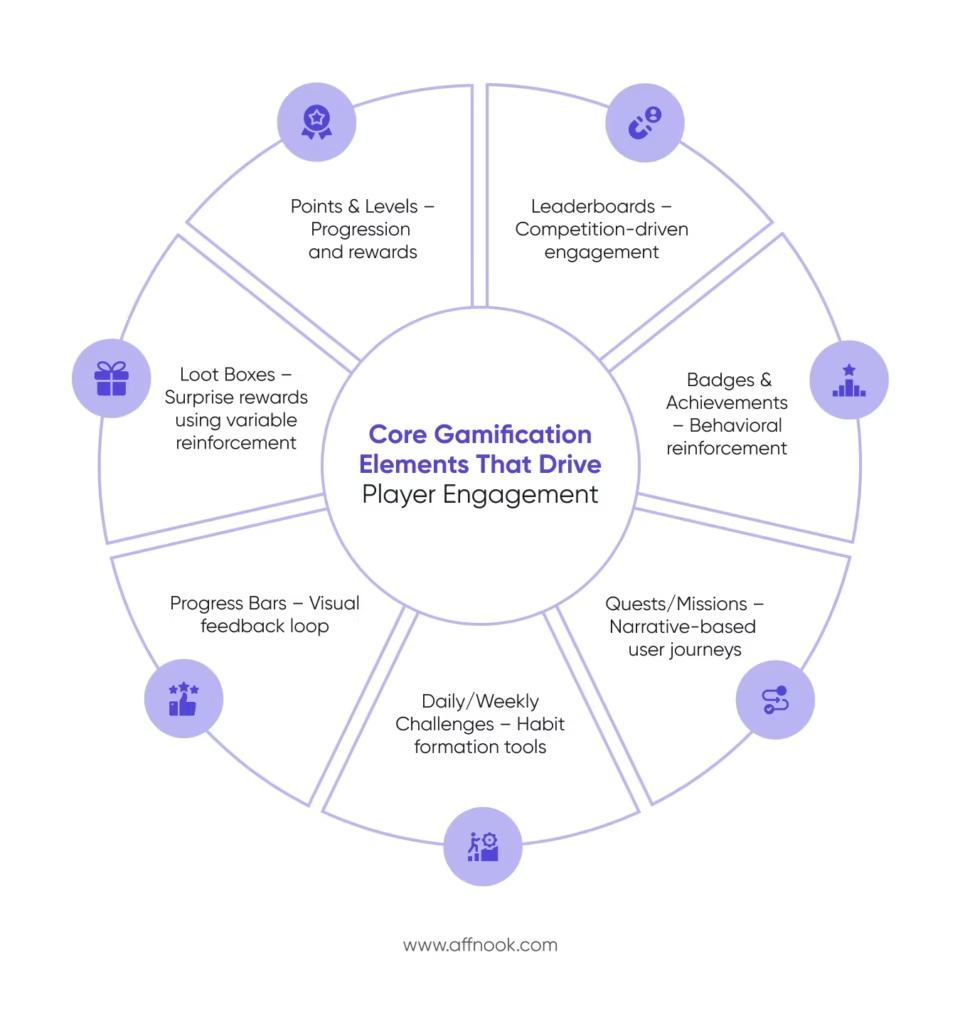
Strategic Implementation: A Step-by-Step Guide for Operators
Adopting gamification in iGaming does not mean adding reward incentives or flashy visuals. It is a planning procedure; it requires correlation with your platform objectives, user behavior, and a long-term vision of engagement.
Step 1: Define Your Objectives
Your first step should be identifying what you want to accomplish. Is it user acquisition, retention, reactivations, average session length, or upsales to premium content? Your gamification framework will have clear objectives that will enable you to measure success accurately.
Step 2: Understand Audience Segments
Various users are driven by various motivators. The low-intensity casual player can enjoy light, rewarding activities, whereas status and exclusivity, as well as competitive leaderboards, are more of a motivator to high-stakes/VIP players. Design user personas based on the behavioral data, and personalize gamification features accordingly.
Step 3: Choose the Right Features
Use analytics to determine what sort of games and user behavior flow through your platform. The next step involves the implementation of appropriate gamification aspects, e.g., progress through the quest to bet more casually, or progressive tournaments to bet competitively. Don’t overdose your platform with gimmicks—instead, it is important to work on features that prompt the user to do what you want them to do.
Step 4: Integrate Seamlessly with UX/UI
Gamification must appear to be a natural feature of your website, not a diversion. Design together with your design team, consider how to authentically introduce elements of gamification into the user interface. Fluid animations, user-friendly layouts, and immediate feedback loops enhance user delight and reduce friction.
Step 5: Set Measurable KPIs
Monitor how gamification works in your business through measuring performance such as retention rate, daily active users (DAU), length of a session, and conversion rate. Set standards to determine the impact of every feature on user behavior.
Step 6: Launch in Phases
Take your gamification approach to testing inside controlled settings. Conduct A/B testing or a beta launch to test variations and obtain feedback before a release. This will help you identify bugs, evaluate the effectiveness, and make sound changes.
Step 7: Monitor, Iterate, and Scale
Gamification is not a plug-and-play strategy. Adapt your approach in real-time using analytics and in-game feedback. Streamline and refactor what works, remove what doesn’t, and continue to push the envelope to be ahead of user expectations.
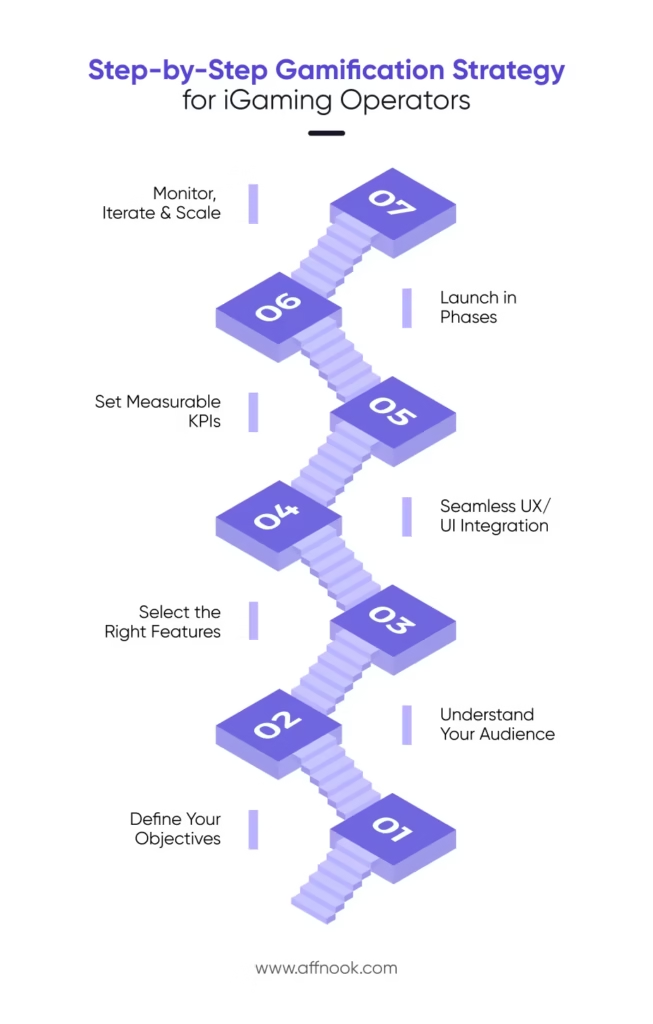
Avoiding Common Pitfalls in Gamification
As much as gamification can open up the iGaming industry to enormous growth, when implemented improperly, the strategies can be counterproductive. To generate the best ROI and satisfaction among players, the operators should not make the following mistakes:
1. Overcomplicating Mechanics
Unnecessary or rather confounding game layers, such as unclear explanation of quests or unclear, messy interfaces, may upset users instead of exciting them. The idea of gamification should complement the main experience, not substitute it.
2. Gimmicks Over Value
Showy images and worthless rewards will get some time, but they are not a long-term solution. Concentrate on the delivery of genuine player-driven value, such as free spins, exclusive content, or status privileges that cater to your platform’s aims.
3. Lack of Personalization
Gamification is not universal. Features can become dull without personalized experiences that understand the behavior of the user and segment them. Individual missions, challenges, and rewards induce closer emotional attachment and dedication.
4. Ignoring Regulatory and Responsible Gaming Standards
Operators should make sure that the gamification artifacts and, in particular, surprise rewards or streak-based incentives do not promote addictive behavior. Act in conformity with the local gaming regulators and input features of responsible gaming into your design.
5. Neglecting Analytics
In the absence of backend analytics, it is impossible to measure the performance. Monitoring KPIs such as retention, conversion, and length should be a regular practice to improve your strategy.
Technology & Tools: Building a Gamification-Ready Platform
The key to successful gamification in the iGaming industry would be to create a tech stack that is flexible, scalable, and closely connected to the data on user behavior to launch it effectively.
In-House Development vs. Third-Party Gamification Tools
The initial step that will have to be made is the in-house development or third-party gamification tools. Although in-house solutions provide maximum control and tailoring, they need internal resources and constant updates. Third-party apps can be deployed quickly by using plug-and-play mechanics, but can be constrained in their scalability.
CRM and Automation Integrations
It is essential to integrate CRM. Real-time automated rewards, progression, and individual notifications are based on the activities of the player as an essential component in effective gamification. By connecting gamified actions to your CRM, you get the opportunity to conduct dynamic segmentation, more targeted marketing, and enhanced retention.
Mobile-First Design
As the sphere of mobile use continues to prevail in iGaming, mobile-first design is a given. The elements of gamification, such as progress bars, daily tasks, and leaderboards, should render well on any smart device to prevent the loss of users.
Scalability and Modularity
Scalability and modularity are also important. Introduce simple missions or levels, then expand the feature, such as a seasonal campaign or social competitions, as engagement increases. The agile backend enables you to innovate and scale without having to redesign your infrastructure.
Security, Compliance, and Anti-Cheat Systems
Last but not least, ensure an emphasis on security, compliance, and anti-cheat tools. Gamified functionality, particularly reward-based, should be in balance with regional laws and not abused.
The technology is not only the base but rather, it is the driver of sustainable gamification success.
Affiliate Angle: Leveraging Gamification for Better Conversions
With the online fight over player attention becoming increasingly fierce, the affiliates have a special advantage: the advertising of brands that apply gamification in iGaming markets. Affiliates have an opportunity to take advantage since the operators that offer engaging missions, progress bars, and loyalty-based rewards become unique in a crowded marketplace.
Gamified platforms not only bring engagement but also grow player lifetime value. This translates into greater retention, along with improved conversions, which ultimately translates into affiliate commissions. It is through promoting such features as USPs in the content, such as reviews, listicles, or video demonstrations, that affiliates can go beyond exclusive bonus codes—they provide experiences.
This is where we have tools such as Affnook, which offers a dedicated dashboard designed specifically for affiliates. Combine that with influencer or streamer partnerships that visually show how quests, point systems, or level-ups work in real-time, and you will get a true, action-generating piece of content.
Simply put, affiliates that recognize and promote gamified operators strategically are not simply creating clicks, but conversions with lifetime loyalty.
Future Trends in Gamification in iGaming
Gamification is the next trend in the iGaming industry that will be highly intelligent, immersive, and community-oriented.
AI-Driven Personalization
AI-based personalization is breaking new ground, and gamification layers will soon be able to dynamically respond to the personal behavior of one player, risk profile, and taste. One can think of dynamic quests, individual reward trajectories, and anticipatory engagement nudges suited to every user.
VR and Metaverse-Style Experiences
Virtual Reality (VR) and metaverse-like experiences are also catching up. In the near future, people will no longer spend their time spinning digital reels but rather strolling in gamified scenario-based worlds, competing at live-action tournaments in virtual arenas, and claiming their rewards in full-scale immersive form.
Social Gamification
Social gamification can also be regarded as a major trend. In the effort to bring more of a community and improve retention rates, operators are experimenting with cohesive play by introducing group quests and team-based missions, as well as clan competitions.
Real-Time Data Gamification
Lastly, there is an increase in real-time data gamification. Operators can use predictive analytics to reward surprise bonuses or open achievements based on in-the-moment performance to turn their casual gaming into an interactive, mentally fulfilling path.
Why Gamification Is No Longer Optional
Keeping ahead of these trends is not an optional decision—it is necessary. The future of gamification will not only make distinction possible to operators who are willing to innovate, but it will enable player loyalty at a scale unseen before.
When designed to a high standard and considering player psychology, gamification in the iGaming industry is a form of long-term growth strategy, rather than a short-term engagement mechanism. It makes retention possible, enhances the lifetime value of your players, and makes your brand stand out in a crowded environment.
However, success cannot be achieved by plugging in with some achievements or badges. Gamification has to be managed as a dynamic and information-based approach, which should correspond to user behavior and platform objectives. It is always a good idea to begin small, say by implementing quests or challenges, measuring the effect using analytics, and making continuous improvements based on the data.
Having the right attitude, technological support, and strategic motive, gamification can shift past its hype status to become a quantifiable profit machine. It is time to become even more elite—experiment, iteration, and turn gameplay into player loyalty.
Help Section
What are the best gamification strategies for increasing player retention in the iGaming industry?
Effective strategies include loyalty programs, progress bars, daily challenges, and tiered rewards. These gamification elements encourage continued gameplay, foster emotional engagement, and create a sense of achievement—leading to increased retention and lifetime value for iGaming operators.
How does gamification in the iGaming industry improve user engagement for online casinos?
Gamification adds interactive, game-like elements such as quests, leaderboards, and point systems. These features tap into psychological triggers like competition and rewards, enhancing the user experience and driving sustained player engagement across online casino platforms.
Which KPIs should iGaming operators track to measure gamification success?
Operators should monitor KPIs like player retention rate, session length, average revenue per user (ARPU), daily active users (DAU), and conversion rates from gamified features. These metrics help measure the impact of gamification on business performance.
Is gamification compliant with gambling regulations in regulated markets?
Yes, but it depends on how it’s implemented. iGaming operators must ensure gamification mechanics don’t mislead users or encourage irresponsible gambling. Regulatory compliance includes clear terms, responsible gaming features, and adherence to jurisdiction-specific rules.
What is the ROI of implementing gamification in iGaming platforms?
Gamification in iGaming industry can yield high ROI by boosting user engagement, increasing player retention, and encouraging repeat deposits. While initial setup may require investment, data shows gamified platforms often outperform traditional models in both revenue and brand loyalty.
